The Roles of Leaders and Managers in Operations: A Case Study of M&S
VerifiedAdded on 2020/06/05
|15
|4161
|44
Report
AI Summary
This report analyzes the roles of leaders and managers within the context of a multinational retailing business, specifically using Mark and Spencer Ltd. as a case study. It begins by differentiating between the functions of managers, who are responsible for administration and operational control, and leaders, who guide and inspire teams. The report then delves into the application of leadership and management in various situational contexts, examining the strengths and weaknesses of different approaches, including trait, behavioral, transactional, and transformational theories. Furthermore, it explores key leadership theories and models such as situational, systems, and contingency leadership. The second part of the report focuses on operational management, the roles of leaders and managers in improving efficiencies, and the factors within the business environment that impact operational decision-making. The report concludes with an evaluation of the application of operations management and the factors impacting the business environment in relation to leadership and management, offering insights into how effective leadership and management contribute to achieving business objectives within a dynamic environment. This report is a comprehensive exploration of leadership and management principles within a real-world business context.
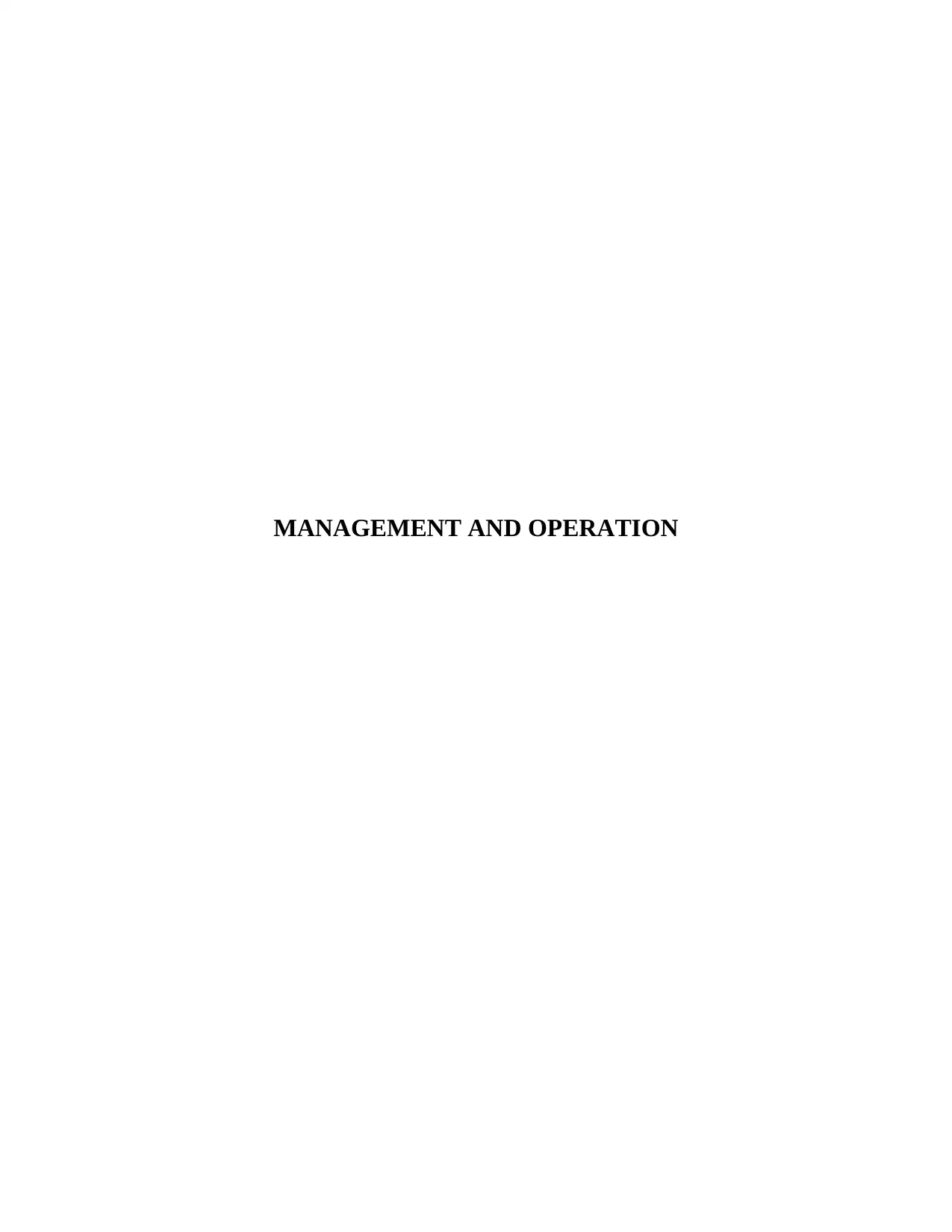
MANAGEMENT AND OPERATION
Paraphrase This Document
Need a fresh take? Get an instant paraphrase of this document with our AI Paraphraser
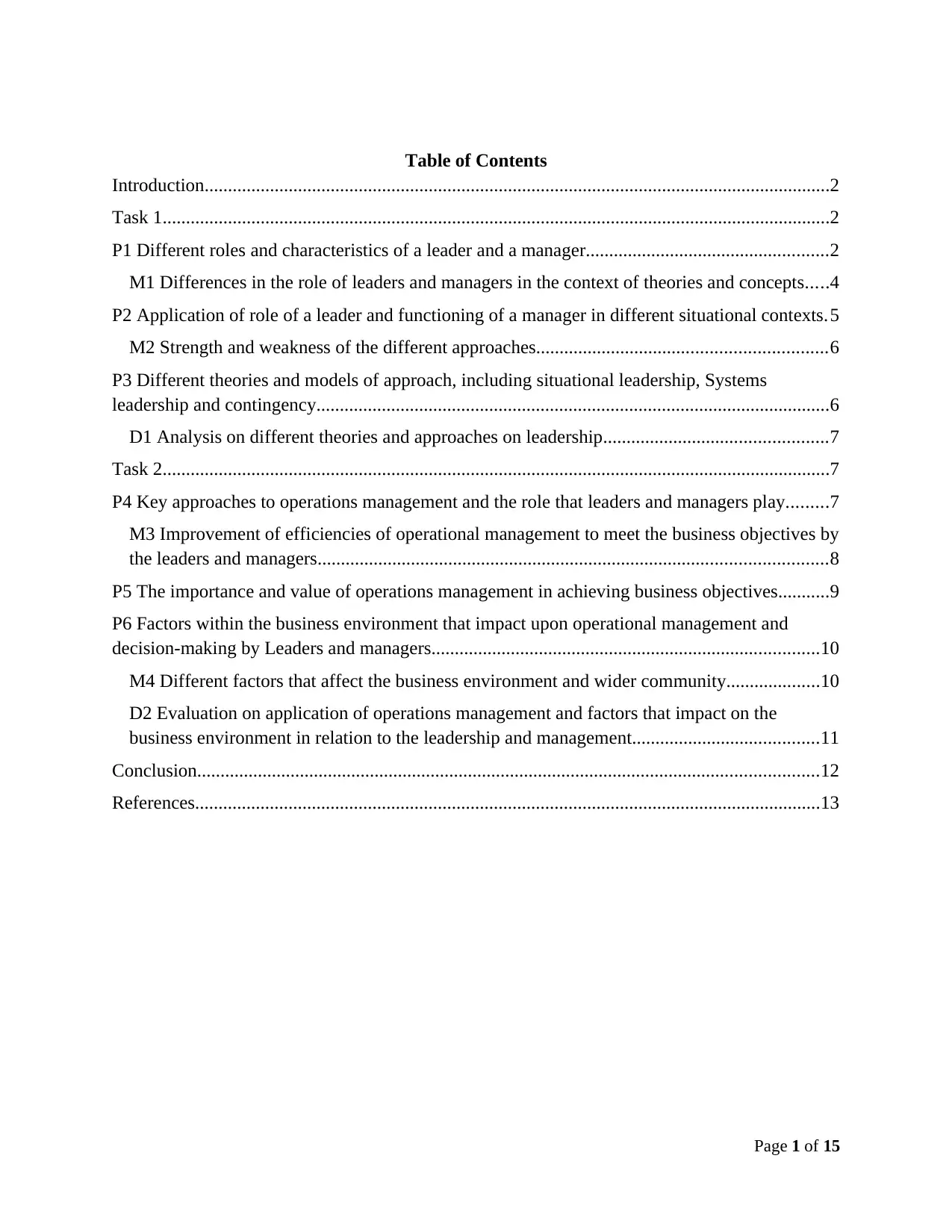
Table of Contents
Introduction......................................................................................................................................2
Task 1...............................................................................................................................................2
P1 Different roles and characteristics of a leader and a manager....................................................2
M1 Differences in the role of leaders and managers in the context of theories and concepts.....4
P2 Application of role of a leader and functioning of a manager in different situational contexts.5
M2 Strength and weakness of the different approaches..............................................................6
P3 Different theories and models of approach, including situational leadership, Systems
leadership and contingency..............................................................................................................6
D1 Analysis on different theories and approaches on leadership................................................7
Task 2...............................................................................................................................................7
P4 Key approaches to operations management and the role that leaders and managers play.........7
M3 Improvement of efficiencies of operational management to meet the business objectives by
the leaders and managers.............................................................................................................8
P5 The importance and value of operations management in achieving business objectives...........9
P6 Factors within the business environment that impact upon operational management and
decision-making by Leaders and managers...................................................................................10
M4 Different factors that affect the business environment and wider community....................10
D2 Evaluation on application of operations management and factors that impact on the
business environment in relation to the leadership and management........................................11
Conclusion.....................................................................................................................................12
References......................................................................................................................................13
Page 1 of 15
Introduction......................................................................................................................................2
Task 1...............................................................................................................................................2
P1 Different roles and characteristics of a leader and a manager....................................................2
M1 Differences in the role of leaders and managers in the context of theories and concepts.....4
P2 Application of role of a leader and functioning of a manager in different situational contexts.5
M2 Strength and weakness of the different approaches..............................................................6
P3 Different theories and models of approach, including situational leadership, Systems
leadership and contingency..............................................................................................................6
D1 Analysis on different theories and approaches on leadership................................................7
Task 2...............................................................................................................................................7
P4 Key approaches to operations management and the role that leaders and managers play.........7
M3 Improvement of efficiencies of operational management to meet the business objectives by
the leaders and managers.............................................................................................................8
P5 The importance and value of operations management in achieving business objectives...........9
P6 Factors within the business environment that impact upon operational management and
decision-making by Leaders and managers...................................................................................10
M4 Different factors that affect the business environment and wider community....................10
D2 Evaluation on application of operations management and factors that impact on the
business environment in relation to the leadership and management........................................11
Conclusion.....................................................................................................................................12
References......................................................................................................................................13
Page 1 of 15

Introduction
The study of the Mark and Spencer Ltd. gives the clear depiction of the multinational retailing
business where the roles of the managers and leaders play a greater part in building the business
more in Westminster and the whole of the UK. The aim of this study is to make out the
differences between the function of a manager with that of a leader in the organisation of Mark
and Spencer Ltd and to provide the various scenarios of opportunities of the business
organisation.
Task 1
P1 Different roles and characteristics of a leader and a manager
Management: Managers are the persons who are solely responsible for the administering of the
business organisation with the determinations and the managing of every other parts of the
business. The generation of the employee recruitments and the principle settings are the
important operations of the business that are go be taken care of by the managers. This can be
well maintained by the managerial skills which the manager maintains in making the control
over his directions of management over the business as well as the team members (Jacob and
Chase, 2013). The manager is the one who takes the ultimate care of the business organisation
like the famous organisation Mark and Spencer ltd (Hajli, 2014).
Role of a manager can be well described in the following ways:
Interpersonal role:
The leadership roles to mentor on the important parts of the business deals, trusting the
employees and assigning the working operations over them.
Liaison roles make him coordinate the organisational in and out observation.
Informational role:
Monitoring of the information both in case of the internal as well as external
environment.
Dissemination of the useful information transmission to the other employees of the
business organisation.
Page 2 of 15
The study of the Mark and Spencer Ltd. gives the clear depiction of the multinational retailing
business where the roles of the managers and leaders play a greater part in building the business
more in Westminster and the whole of the UK. The aim of this study is to make out the
differences between the function of a manager with that of a leader in the organisation of Mark
and Spencer Ltd and to provide the various scenarios of opportunities of the business
organisation.
Task 1
P1 Different roles and characteristics of a leader and a manager
Management: Managers are the persons who are solely responsible for the administering of the
business organisation with the determinations and the managing of every other parts of the
business. The generation of the employee recruitments and the principle settings are the
important operations of the business that are go be taken care of by the managers. This can be
well maintained by the managerial skills which the manager maintains in making the control
over his directions of management over the business as well as the team members (Jacob and
Chase, 2013). The manager is the one who takes the ultimate care of the business organisation
like the famous organisation Mark and Spencer ltd (Hajli, 2014).
Role of a manager can be well described in the following ways:
Interpersonal role:
The leadership roles to mentor on the important parts of the business deals, trusting the
employees and assigning the working operations over them.
Liaison roles make him coordinate the organisational in and out observation.
Informational role:
Monitoring of the information both in case of the internal as well as external
environment.
Dissemination of the useful information transmission to the other employees of the
business organisation.
Page 2 of 15
⊘ This is a preview!⊘
Do you want full access?
Subscribe today to unlock all pages.

Trusted by 1+ million students worldwide
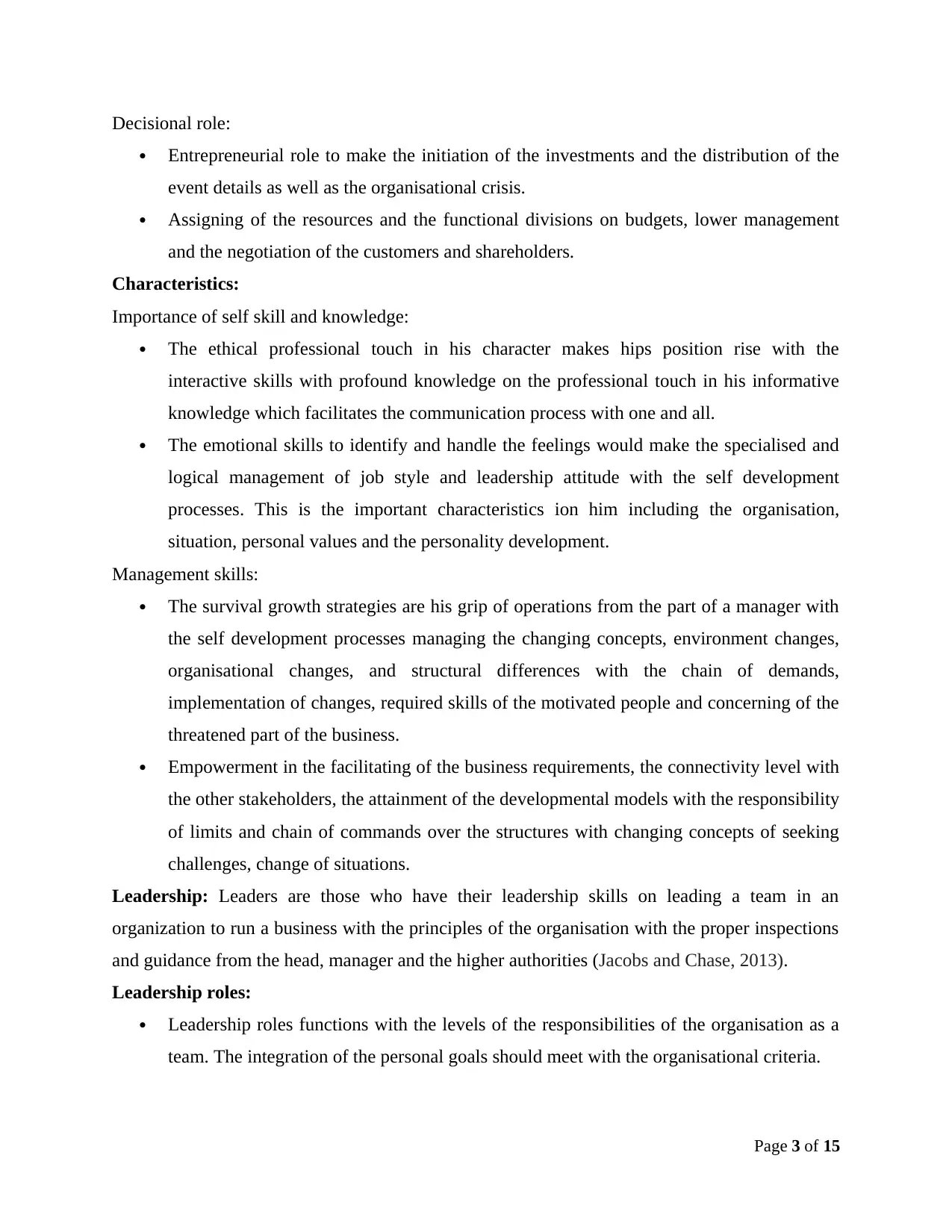
Decisional role:
Entrepreneurial role to make the initiation of the investments and the distribution of the
event details as well as the organisational crisis.
Assigning of the resources and the functional divisions on budgets, lower management
and the negotiation of the customers and shareholders.
Characteristics:
Importance of self skill and knowledge:
The ethical professional touch in his character makes hips position rise with the
interactive skills with profound knowledge on the professional touch in his informative
knowledge which facilitates the communication process with one and all.
The emotional skills to identify and handle the feelings would make the specialised and
logical management of job style and leadership attitude with the self development
processes. This is the important characteristics ion him including the organisation,
situation, personal values and the personality development.
Management skills:
The survival growth strategies are his grip of operations from the part of a manager with
the self development processes managing the changing concepts, environment changes,
organisational changes, and structural differences with the chain of demands,
implementation of changes, required skills of the motivated people and concerning of the
threatened part of the business.
Empowerment in the facilitating of the business requirements, the connectivity level with
the other stakeholders, the attainment of the developmental models with the responsibility
of limits and chain of commands over the structures with changing concepts of seeking
challenges, change of situations.
Leadership: Leaders are those who have their leadership skills on leading a team in an
organization to run a business with the principles of the organisation with the proper inspections
and guidance from the head, manager and the higher authorities (Jacobs and Chase, 2013).
Leadership roles:
Leadership roles functions with the levels of the responsibilities of the organisation as a
team. The integration of the personal goals should meet with the organisational criteria.
Page 3 of 15
Entrepreneurial role to make the initiation of the investments and the distribution of the
event details as well as the organisational crisis.
Assigning of the resources and the functional divisions on budgets, lower management
and the negotiation of the customers and shareholders.
Characteristics:
Importance of self skill and knowledge:
The ethical professional touch in his character makes hips position rise with the
interactive skills with profound knowledge on the professional touch in his informative
knowledge which facilitates the communication process with one and all.
The emotional skills to identify and handle the feelings would make the specialised and
logical management of job style and leadership attitude with the self development
processes. This is the important characteristics ion him including the organisation,
situation, personal values and the personality development.
Management skills:
The survival growth strategies are his grip of operations from the part of a manager with
the self development processes managing the changing concepts, environment changes,
organisational changes, and structural differences with the chain of demands,
implementation of changes, required skills of the motivated people and concerning of the
threatened part of the business.
Empowerment in the facilitating of the business requirements, the connectivity level with
the other stakeholders, the attainment of the developmental models with the responsibility
of limits and chain of commands over the structures with changing concepts of seeking
challenges, change of situations.
Leadership: Leaders are those who have their leadership skills on leading a team in an
organization to run a business with the principles of the organisation with the proper inspections
and guidance from the head, manager and the higher authorities (Jacobs and Chase, 2013).
Leadership roles:
Leadership roles functions with the levels of the responsibilities of the organisation as a
team. The integration of the personal goals should meet with the organisational criteria.
Page 3 of 15
Paraphrase This Document
Need a fresh take? Get an instant paraphrase of this document with our AI Paraphraser
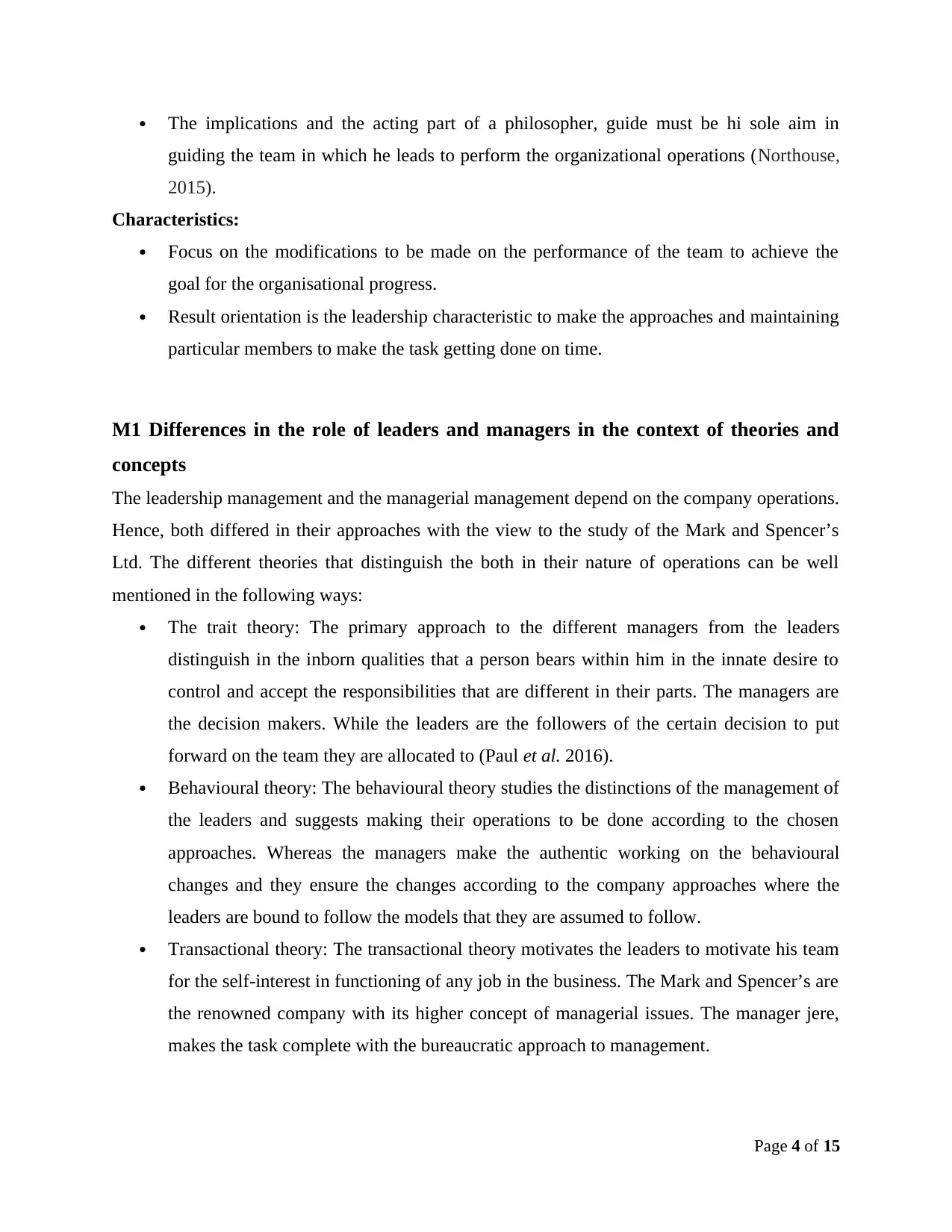
The implications and the acting part of a philosopher, guide must be hi sole aim in
guiding the team in which he leads to perform the organizational operations (Northouse,
2015).
Characteristics:
Focus on the modifications to be made on the performance of the team to achieve the
goal for the organisational progress.
Result orientation is the leadership characteristic to make the approaches and maintaining
particular members to make the task getting done on time.
M1 Differences in the role of leaders and managers in the context of theories and
concepts
The leadership management and the managerial management depend on the company operations.
Hence, both differed in their approaches with the view to the study of the Mark and Spencer’s
Ltd. The different theories that distinguish the both in their nature of operations can be well
mentioned in the following ways:
The trait theory: The primary approach to the different managers from the leaders
distinguish in the inborn qualities that a person bears within him in the innate desire to
control and accept the responsibilities that are different in their parts. The managers are
the decision makers. While the leaders are the followers of the certain decision to put
forward on the team they are allocated to (Paul et al. 2016).
Behavioural theory: The behavioural theory studies the distinctions of the management of
the leaders and suggests making their operations to be done according to the chosen
approaches. Whereas the managers make the authentic working on the behavioural
changes and they ensure the changes according to the company approaches where the
leaders are bound to follow the models that they are assumed to follow.
Transactional theory: The transactional theory motivates the leaders to motivate his team
for the self-interest in functioning of any job in the business. The Mark and Spencer’s are
the renowned company with its higher concept of managerial issues. The manager jere,
makes the task complete with the bureaucratic approach to management.
Page 4 of 15
guiding the team in which he leads to perform the organizational operations (Northouse,
2015).
Characteristics:
Focus on the modifications to be made on the performance of the team to achieve the
goal for the organisational progress.
Result orientation is the leadership characteristic to make the approaches and maintaining
particular members to make the task getting done on time.
M1 Differences in the role of leaders and managers in the context of theories and
concepts
The leadership management and the managerial management depend on the company operations.
Hence, both differed in their approaches with the view to the study of the Mark and Spencer’s
Ltd. The different theories that distinguish the both in their nature of operations can be well
mentioned in the following ways:
The trait theory: The primary approach to the different managers from the leaders
distinguish in the inborn qualities that a person bears within him in the innate desire to
control and accept the responsibilities that are different in their parts. The managers are
the decision makers. While the leaders are the followers of the certain decision to put
forward on the team they are allocated to (Paul et al. 2016).
Behavioural theory: The behavioural theory studies the distinctions of the management of
the leaders and suggests making their operations to be done according to the chosen
approaches. Whereas the managers make the authentic working on the behavioural
changes and they ensure the changes according to the company approaches where the
leaders are bound to follow the models that they are assumed to follow.
Transactional theory: The transactional theory motivates the leaders to motivate his team
for the self-interest in functioning of any job in the business. The Mark and Spencer’s are
the renowned company with its higher concept of managerial issues. The manager jere,
makes the task complete with the bureaucratic approach to management.
Page 4 of 15

Transformational theory: The transformational management depend on the approach of
the personal presence in the organisation. The leaders here, should be aware of the
company rule and regulations for the team management (Spalding et al. 2014).
Charismatic theory: The charismatic approach leads the powerful sense of the few models
that needs to be transformational in the nature. The managers make the rewards for the
better operations in the particular field for the leaders who make it worth working.
P2 Application of role of a leader and functioning of a manager in different
situational contexts
Functioning of Managers Role of Leaders
Functions of the spokesperson role
make the positive influence on the
working employees and the
organisation itself.
The team leader maintains the entrepreneurial
suggestions and the achieving objectives should be the
prime urge to accomplish the leadership traits.
Figured role leads him to
symbolise the organisational
perspectives with the achievement
of the targets.
Clear understanding of the individual responsibilities is
the important characteristics of a leader with the
behavioural management and the organising of the jobs
with self motivation, control and the guidance for
forming the team a better one (Hajli, 2014).
The identity of the self aspiration
and the technical skills that would
make a manager apt with his
criteria of being one among the lot.
Leaders make priority on meeting the jobs to be done
exactly with the team individuals.
Page 5 of 15
the personal presence in the organisation. The leaders here, should be aware of the
company rule and regulations for the team management (Spalding et al. 2014).
Charismatic theory: The charismatic approach leads the powerful sense of the few models
that needs to be transformational in the nature. The managers make the rewards for the
better operations in the particular field for the leaders who make it worth working.
P2 Application of role of a leader and functioning of a manager in different
situational contexts
Functioning of Managers Role of Leaders
Functions of the spokesperson role
make the positive influence on the
working employees and the
organisation itself.
The team leader maintains the entrepreneurial
suggestions and the achieving objectives should be the
prime urge to accomplish the leadership traits.
Figured role leads him to
symbolise the organisational
perspectives with the achievement
of the targets.
Clear understanding of the individual responsibilities is
the important characteristics of a leader with the
behavioural management and the organising of the jobs
with self motivation, control and the guidance for
forming the team a better one (Hajli, 2014).
The identity of the self aspiration
and the technical skills that would
make a manager apt with his
criteria of being one among the lot.
Leaders make priority on meeting the jobs to be done
exactly with the team individuals.
Page 5 of 15
⊘ This is a preview!⊘
Do you want full access?
Subscribe today to unlock all pages.

Trusted by 1+ million students worldwide
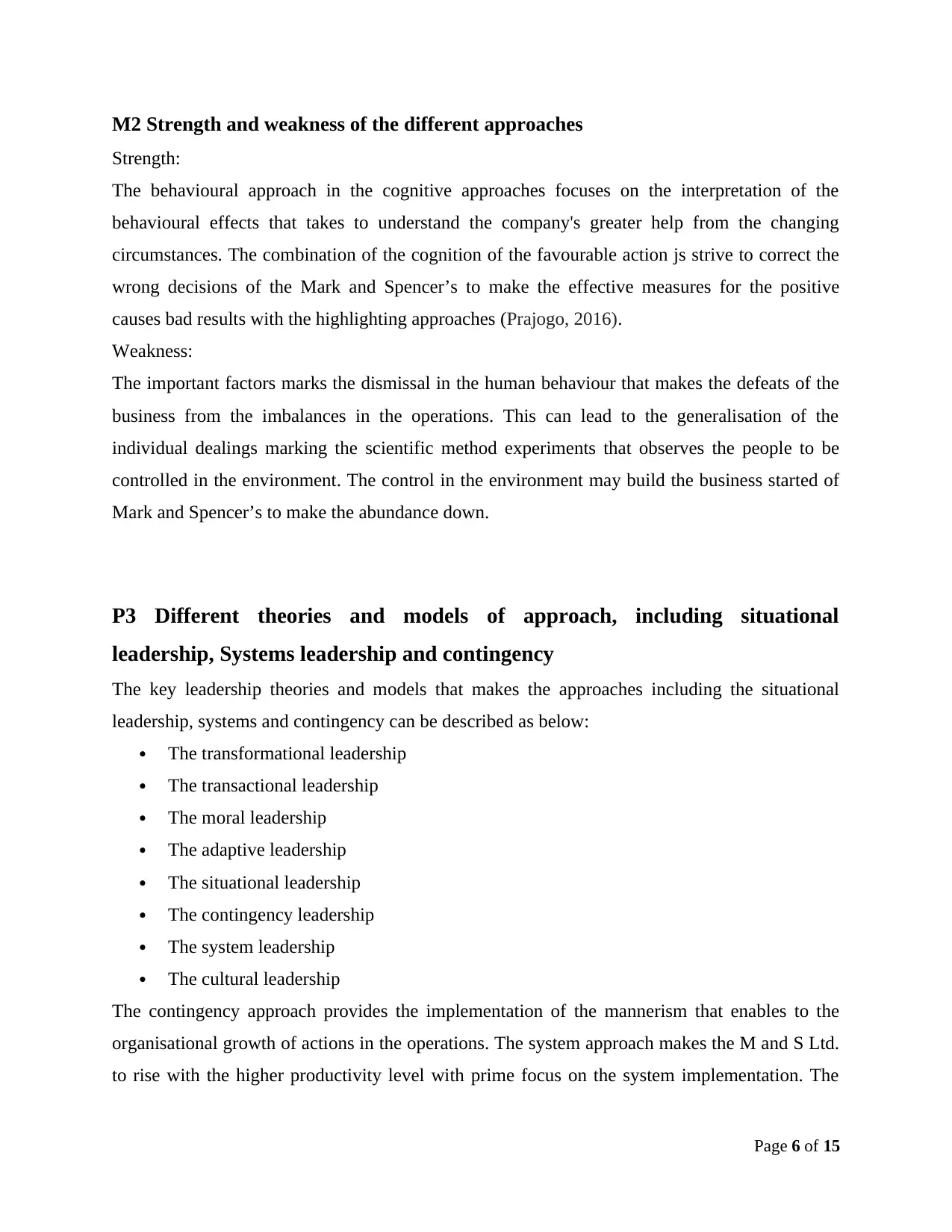
M2 Strength and weakness of the different approaches
Strength:
The behavioural approach in the cognitive approaches focuses on the interpretation of the
behavioural effects that takes to understand the company's greater help from the changing
circumstances. The combination of the cognition of the favourable action js strive to correct the
wrong decisions of the Mark and Spencer’s to make the effective measures for the positive
causes bad results with the highlighting approaches (Prajogo, 2016).
Weakness:
The important factors marks the dismissal in the human behaviour that makes the defeats of the
business from the imbalances in the operations. This can lead to the generalisation of the
individual dealings marking the scientific method experiments that observes the people to be
controlled in the environment. The control in the environment may build the business started of
Mark and Spencer’s to make the abundance down.
P3 Different theories and models of approach, including situational
leadership, Systems leadership and contingency
The key leadership theories and models that makes the approaches including the situational
leadership, systems and contingency can be described as below:
The transformational leadership
The transactional leadership
The moral leadership
The adaptive leadership
The situational leadership
The contingency leadership
The system leadership
The cultural leadership
The contingency approach provides the implementation of the mannerism that enables to the
organisational growth of actions in the operations. The system approach makes the M and S Ltd.
to rise with the higher productivity level with prime focus on the system implementation. The
Page 6 of 15
Strength:
The behavioural approach in the cognitive approaches focuses on the interpretation of the
behavioural effects that takes to understand the company's greater help from the changing
circumstances. The combination of the cognition of the favourable action js strive to correct the
wrong decisions of the Mark and Spencer’s to make the effective measures for the positive
causes bad results with the highlighting approaches (Prajogo, 2016).
Weakness:
The important factors marks the dismissal in the human behaviour that makes the defeats of the
business from the imbalances in the operations. This can lead to the generalisation of the
individual dealings marking the scientific method experiments that observes the people to be
controlled in the environment. The control in the environment may build the business started of
Mark and Spencer’s to make the abundance down.
P3 Different theories and models of approach, including situational
leadership, Systems leadership and contingency
The key leadership theories and models that makes the approaches including the situational
leadership, systems and contingency can be described as below:
The transformational leadership
The transactional leadership
The moral leadership
The adaptive leadership
The situational leadership
The contingency leadership
The system leadership
The cultural leadership
The contingency approach provides the implementation of the mannerism that enables to the
organisational growth of actions in the operations. The system approach makes the M and S Ltd.
to rise with the higher productivity level with prime focus on the system implementation. The
Page 6 of 15
Paraphrase This Document
Need a fresh take? Get an instant paraphrase of this document with our AI Paraphraser
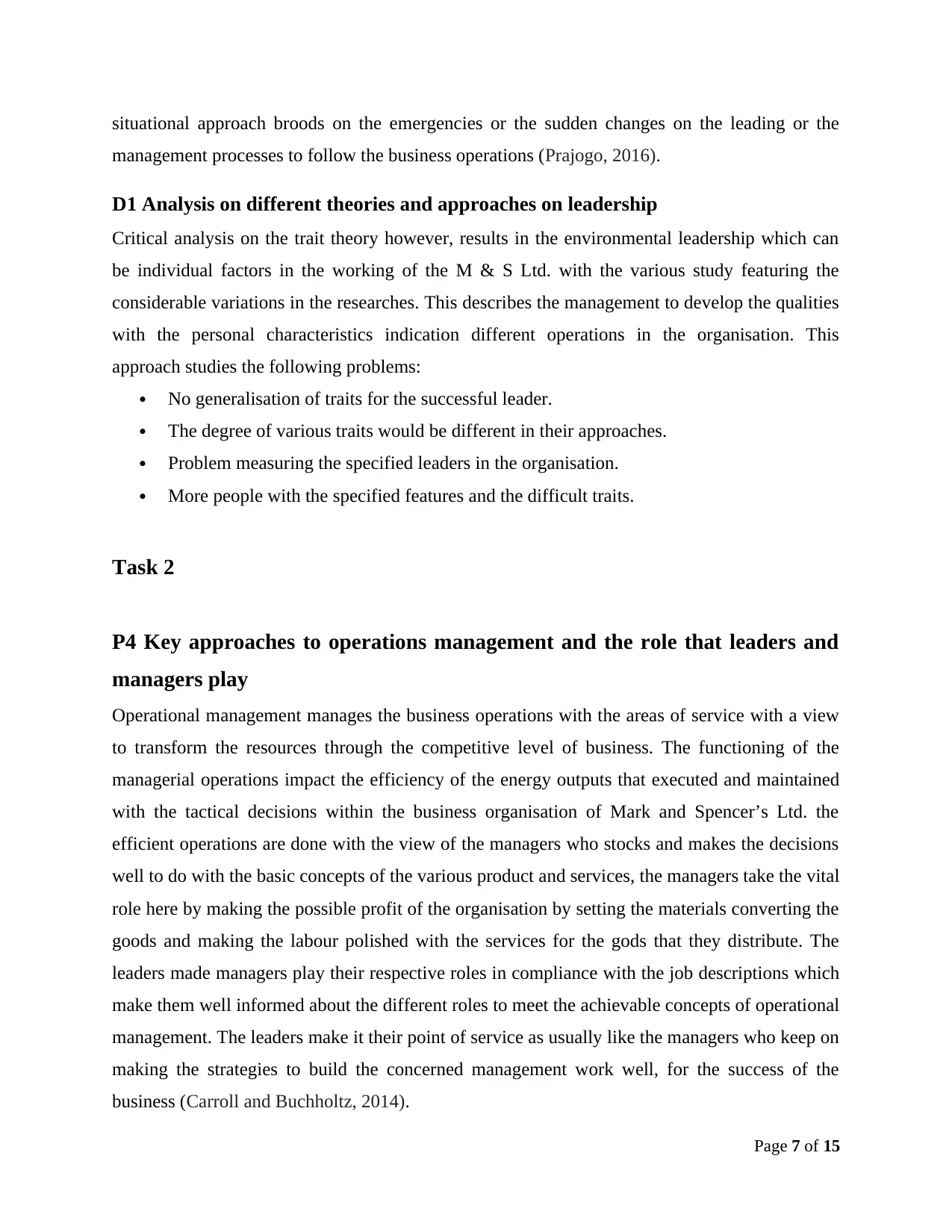
situational approach broods on the emergencies or the sudden changes on the leading or the
management processes to follow the business operations (Prajogo, 2016).
D1 Analysis on different theories and approaches on leadership
Critical analysis on the trait theory however, results in the environmental leadership which can
be individual factors in the working of the M & S Ltd. with the various study featuring the
considerable variations in the researches. This describes the management to develop the qualities
with the personal characteristics indication different operations in the organisation. This
approach studies the following problems:
No generalisation of traits for the successful leader.
The degree of various traits would be different in their approaches.
Problem measuring the specified leaders in the organisation.
More people with the specified features and the difficult traits.
Task 2
P4 Key approaches to operations management and the role that leaders and
managers play
Operational management manages the business operations with the areas of service with a view
to transform the resources through the competitive level of business. The functioning of the
managerial operations impact the efficiency of the energy outputs that executed and maintained
with the tactical decisions within the business organisation of Mark and Spencer’s Ltd. the
efficient operations are done with the view of the managers who stocks and makes the decisions
well to do with the basic concepts of the various product and services, the managers take the vital
role here by making the possible profit of the organisation by setting the materials converting the
goods and making the labour polished with the services for the gods that they distribute. The
leaders made managers play their respective roles in compliance with the job descriptions which
make them well informed about the different roles to meet the achievable concepts of operational
management. The leaders make it their point of service as usually like the managers who keep on
making the strategies to build the concerned management work well, for the success of the
business (Carroll and Buchholtz, 2014).
Page 7 of 15
management processes to follow the business operations (Prajogo, 2016).
D1 Analysis on different theories and approaches on leadership
Critical analysis on the trait theory however, results in the environmental leadership which can
be individual factors in the working of the M & S Ltd. with the various study featuring the
considerable variations in the researches. This describes the management to develop the qualities
with the personal characteristics indication different operations in the organisation. This
approach studies the following problems:
No generalisation of traits for the successful leader.
The degree of various traits would be different in their approaches.
Problem measuring the specified leaders in the organisation.
More people with the specified features and the difficult traits.
Task 2
P4 Key approaches to operations management and the role that leaders and
managers play
Operational management manages the business operations with the areas of service with a view
to transform the resources through the competitive level of business. The functioning of the
managerial operations impact the efficiency of the energy outputs that executed and maintained
with the tactical decisions within the business organisation of Mark and Spencer’s Ltd. the
efficient operations are done with the view of the managers who stocks and makes the decisions
well to do with the basic concepts of the various product and services, the managers take the vital
role here by making the possible profit of the organisation by setting the materials converting the
goods and making the labour polished with the services for the gods that they distribute. The
leaders made managers play their respective roles in compliance with the job descriptions which
make them well informed about the different roles to meet the achievable concepts of operational
management. The leaders make it their point of service as usually like the managers who keep on
making the strategies to build the concerned management work well, for the success of the
business (Carroll and Buchholtz, 2014).
Page 7 of 15
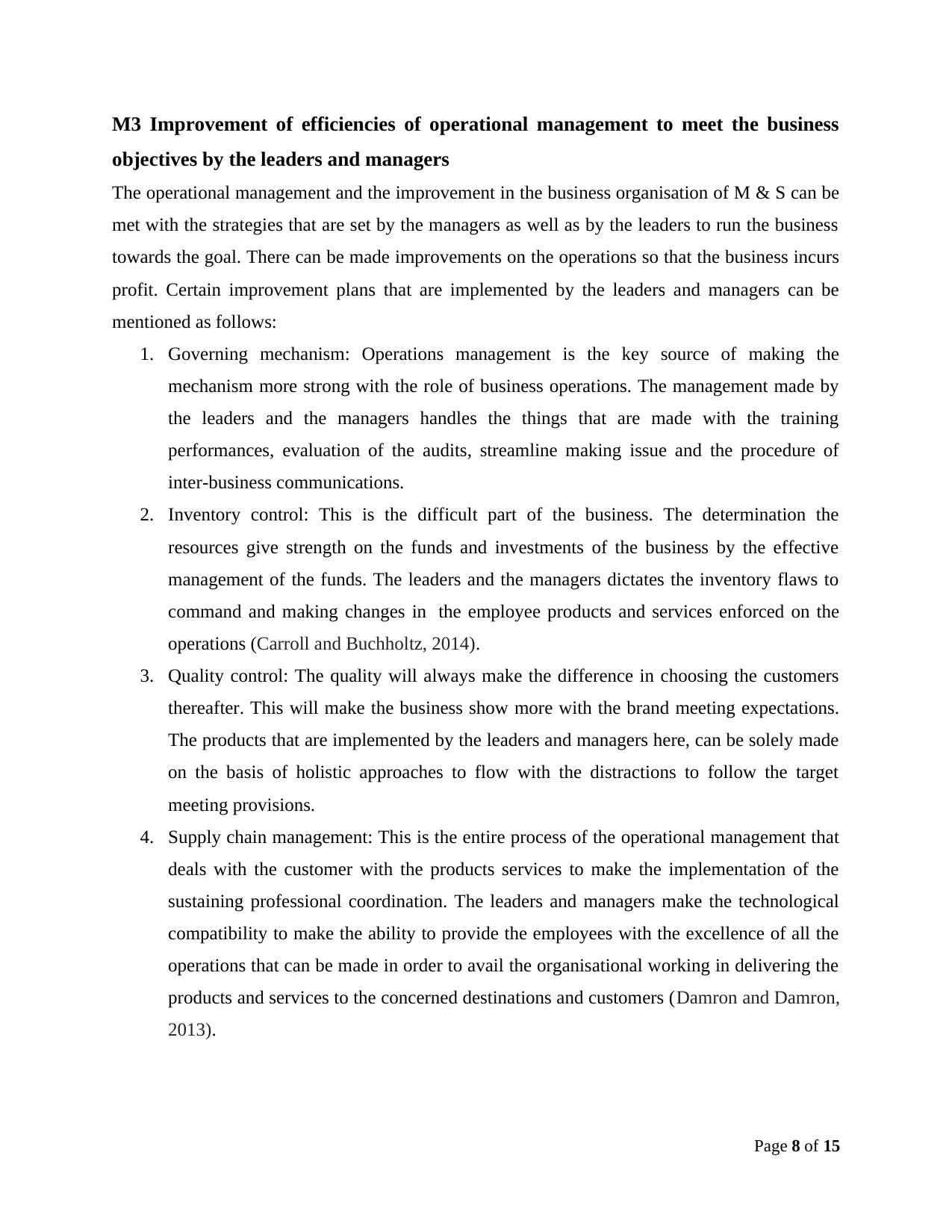
M3 Improvement of efficiencies of operational management to meet the business
objectives by the leaders and managers
The operational management and the improvement in the business organisation of M & S can be
met with the strategies that are set by the managers as well as by the leaders to run the business
towards the goal. There can be made improvements on the operations so that the business incurs
profit. Certain improvement plans that are implemented by the leaders and managers can be
mentioned as follows:
1. Governing mechanism: Operations management is the key source of making the
mechanism more strong with the role of business operations. The management made by
the leaders and the managers handles the things that are made with the training
performances, evaluation of the audits, streamline making issue and the procedure of
inter-business communications.
2. Inventory control: This is the difficult part of the business. The determination the
resources give strength on the funds and investments of the business by the effective
management of the funds. The leaders and the managers dictates the inventory flaws to
command and making changes in the employee products and services enforced on the
operations (Carroll and Buchholtz, 2014).
3. Quality control: The quality will always make the difference in choosing the customers
thereafter. This will make the business show more with the brand meeting expectations.
The products that are implemented by the leaders and managers here, can be solely made
on the basis of holistic approaches to flow with the distractions to follow the target
meeting provisions.
4. Supply chain management: This is the entire process of the operational management that
deals with the customer with the products services to make the implementation of the
sustaining professional coordination. The leaders and managers make the technological
compatibility to make the ability to provide the employees with the excellence of all the
operations that can be made in order to avail the organisational working in delivering the
products and services to the concerned destinations and customers (Damron and Damron,
2013).
Page 8 of 15
objectives by the leaders and managers
The operational management and the improvement in the business organisation of M & S can be
met with the strategies that are set by the managers as well as by the leaders to run the business
towards the goal. There can be made improvements on the operations so that the business incurs
profit. Certain improvement plans that are implemented by the leaders and managers can be
mentioned as follows:
1. Governing mechanism: Operations management is the key source of making the
mechanism more strong with the role of business operations. The management made by
the leaders and the managers handles the things that are made with the training
performances, evaluation of the audits, streamline making issue and the procedure of
inter-business communications.
2. Inventory control: This is the difficult part of the business. The determination the
resources give strength on the funds and investments of the business by the effective
management of the funds. The leaders and the managers dictates the inventory flaws to
command and making changes in the employee products and services enforced on the
operations (Carroll and Buchholtz, 2014).
3. Quality control: The quality will always make the difference in choosing the customers
thereafter. This will make the business show more with the brand meeting expectations.
The products that are implemented by the leaders and managers here, can be solely made
on the basis of holistic approaches to flow with the distractions to follow the target
meeting provisions.
4. Supply chain management: This is the entire process of the operational management that
deals with the customer with the products services to make the implementation of the
sustaining professional coordination. The leaders and managers make the technological
compatibility to make the ability to provide the employees with the excellence of all the
operations that can be made in order to avail the organisational working in delivering the
products and services to the concerned destinations and customers (Damron and Damron,
2013).
Page 8 of 15
⊘ This is a preview!⊘
Do you want full access?
Subscribe today to unlock all pages.

Trusted by 1+ million students worldwide

P5 The importance and value of operations management in achieving business
objectives
The importance of business objective regards the planning and the strategic formulation of plans
that contributes the operations and the further taking care of the other product consideration. The
values and the operations are well managed in achieving the business objectives creating the
processes of operations that make the starting of the business to make the involvement of
happiness steadier with the operational management. This refers to the business practices with
the covering of the materials into goods with the efficiency in them management and leadership
skills to work out the business of Mark and Spencers Ltd. to stand among the other businesses in
the markets of the UK. This also refers to the involvement of the organisational operations that
controls the management activities of the complexity of the business. The value of the operations
management needs to be worked out in achieving the business objectives because this sets the
overall strategy of the whole business (Chevalier et al. 2015).
Figure 1: Operational management
Source: (Chevalier et al. 2015)
Page 9 of 15
objectives
The importance of business objective regards the planning and the strategic formulation of plans
that contributes the operations and the further taking care of the other product consideration. The
values and the operations are well managed in achieving the business objectives creating the
processes of operations that make the starting of the business to make the involvement of
happiness steadier with the operational management. This refers to the business practices with
the covering of the materials into goods with the efficiency in them management and leadership
skills to work out the business of Mark and Spencers Ltd. to stand among the other businesses in
the markets of the UK. This also refers to the involvement of the organisational operations that
controls the management activities of the complexity of the business. The value of the operations
management needs to be worked out in achieving the business objectives because this sets the
overall strategy of the whole business (Chevalier et al. 2015).
Figure 1: Operational management
Source: (Chevalier et al. 2015)
Page 9 of 15
Paraphrase This Document
Need a fresh take? Get an instant paraphrase of this document with our AI Paraphraser
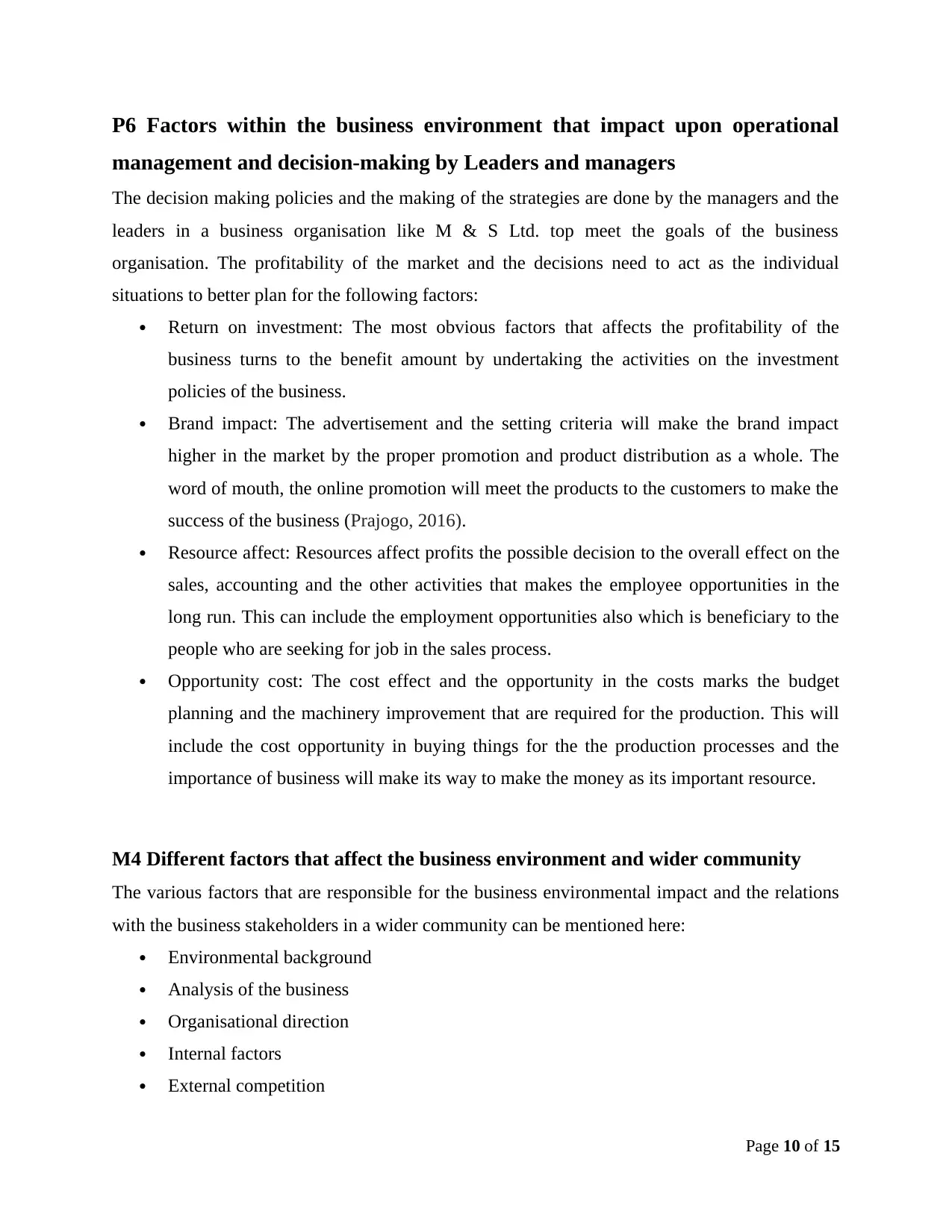
P6 Factors within the business environment that impact upon operational
management and decision-making by Leaders and managers
The decision making policies and the making of the strategies are done by the managers and the
leaders in a business organisation like M & S Ltd. top meet the goals of the business
organisation. The profitability of the market and the decisions need to act as the individual
situations to better plan for the following factors:
Return on investment: The most obvious factors that affects the profitability of the
business turns to the benefit amount by undertaking the activities on the investment
policies of the business.
Brand impact: The advertisement and the setting criteria will make the brand impact
higher in the market by the proper promotion and product distribution as a whole. The
word of mouth, the online promotion will meet the products to the customers to make the
success of the business (Prajogo, 2016).
Resource affect: Resources affect profits the possible decision to the overall effect on the
sales, accounting and the other activities that makes the employee opportunities in the
long run. This can include the employment opportunities also which is beneficiary to the
people who are seeking for job in the sales process.
Opportunity cost: The cost effect and the opportunity in the costs marks the budget
planning and the machinery improvement that are required for the production. This will
include the cost opportunity in buying things for the the production processes and the
importance of business will make its way to make the money as its important resource.
M4 Different factors that affect the business environment and wider community
The various factors that are responsible for the business environmental impact and the relations
with the business stakeholders in a wider community can be mentioned here:
Environmental background
Analysis of the business
Organisational direction
Internal factors
External competition
Page 10 of 15
management and decision-making by Leaders and managers
The decision making policies and the making of the strategies are done by the managers and the
leaders in a business organisation like M & S Ltd. top meet the goals of the business
organisation. The profitability of the market and the decisions need to act as the individual
situations to better plan for the following factors:
Return on investment: The most obvious factors that affects the profitability of the
business turns to the benefit amount by undertaking the activities on the investment
policies of the business.
Brand impact: The advertisement and the setting criteria will make the brand impact
higher in the market by the proper promotion and product distribution as a whole. The
word of mouth, the online promotion will meet the products to the customers to make the
success of the business (Prajogo, 2016).
Resource affect: Resources affect profits the possible decision to the overall effect on the
sales, accounting and the other activities that makes the employee opportunities in the
long run. This can include the employment opportunities also which is beneficiary to the
people who are seeking for job in the sales process.
Opportunity cost: The cost effect and the opportunity in the costs marks the budget
planning and the machinery improvement that are required for the production. This will
include the cost opportunity in buying things for the the production processes and the
importance of business will make its way to make the money as its important resource.
M4 Different factors that affect the business environment and wider community
The various factors that are responsible for the business environmental impact and the relations
with the business stakeholders in a wider community can be mentioned here:
Environmental background
Analysis of the business
Organisational direction
Internal factors
External competition
Page 10 of 15

D2 Evaluation on application of operations management and factors that impact on
the business environment in relation to the leadership and management
Mark and Spencer’s Ltd. have their business with the focus on the retail shop items including the
groceries and clothing stuffs as well. Their brand is widely known and has their effect on the
different parts of the world. The company, therefore, targets the broader extension of their
business to the other competitor market and the manufacturers who will be well introduced to the
licensing on the brands as per their rules (Carroll and Buchholtz, 2014). The business is affected
by the collective sources that are impacted by the environment. Following are the factors that
impacts on the business environment in relation to the leadership and management:
1. Political environment: The political environment affects a business with it environmental
influence to a larger extent. The philosophy, government ideology and the nature of
extension of the business must be concerned because it affects the relationship
management between organizational leadership and the management as a whole. The
environment restricts in the growth processes in the multinational markets with the
automatic growth in the country's policies.
2. Economic environment: Economic growth influences the business structure in every way
of the investment processes, sales and the marketing of the goods and services in the
market. The environment as the national structure is designed with the economic vitality.
This impacts the relationship among the leaders and the answers to maintain the
performance levels of the M & S business ltd. the economic crisis can also be a serious
issue in meeting the crisis. The economic prosperity and the gross domestic production
meets the annual comparisons with the business strategies with the other businesses in the
market of the UK. The starting points of the business have marked the poverty line,
however, the per capita income of the business produced the satisfactory growth in one
year which is divided by the country's population.
3. Social environment: The country’s social environment gets affected with the business
affect. The business establishes the customers satisfaction, business operations with the
relation of the leadership and managerial policies as well, as the seniority respects,
mobility of the labour and the place concern. The fashion and the trend also goes side by
side with the socially portrayed cost structure, customs, conventions, cultural heritage and
the socio-cultural environment (Hajli, 2014).
Page 11 of 15
the business environment in relation to the leadership and management
Mark and Spencer’s Ltd. have their business with the focus on the retail shop items including the
groceries and clothing stuffs as well. Their brand is widely known and has their effect on the
different parts of the world. The company, therefore, targets the broader extension of their
business to the other competitor market and the manufacturers who will be well introduced to the
licensing on the brands as per their rules (Carroll and Buchholtz, 2014). The business is affected
by the collective sources that are impacted by the environment. Following are the factors that
impacts on the business environment in relation to the leadership and management:
1. Political environment: The political environment affects a business with it environmental
influence to a larger extent. The philosophy, government ideology and the nature of
extension of the business must be concerned because it affects the relationship
management between organizational leadership and the management as a whole. The
environment restricts in the growth processes in the multinational markets with the
automatic growth in the country's policies.
2. Economic environment: Economic growth influences the business structure in every way
of the investment processes, sales and the marketing of the goods and services in the
market. The environment as the national structure is designed with the economic vitality.
This impacts the relationship among the leaders and the answers to maintain the
performance levels of the M & S business ltd. the economic crisis can also be a serious
issue in meeting the crisis. The economic prosperity and the gross domestic production
meets the annual comparisons with the business strategies with the other businesses in the
market of the UK. The starting points of the business have marked the poverty line,
however, the per capita income of the business produced the satisfactory growth in one
year which is divided by the country's population.
3. Social environment: The country’s social environment gets affected with the business
affect. The business establishes the customers satisfaction, business operations with the
relation of the leadership and managerial policies as well, as the seniority respects,
mobility of the labour and the place concern. The fashion and the trend also goes side by
side with the socially portrayed cost structure, customs, conventions, cultural heritage and
the socio-cultural environment (Hajli, 2014).
Page 11 of 15
⊘ This is a preview!⊘
Do you want full access?
Subscribe today to unlock all pages.

Trusted by 1+ million students worldwide
1 out of 15
Related Documents
Your All-in-One AI-Powered Toolkit for Academic Success.
+13062052269
info@desklib.com
Available 24*7 on WhatsApp / Email
![[object Object]](/_next/static/media/star-bottom.7253800d.svg)
Unlock your academic potential
Copyright © 2020–2025 A2Z Services. All Rights Reserved. Developed and managed by ZUCOL.





